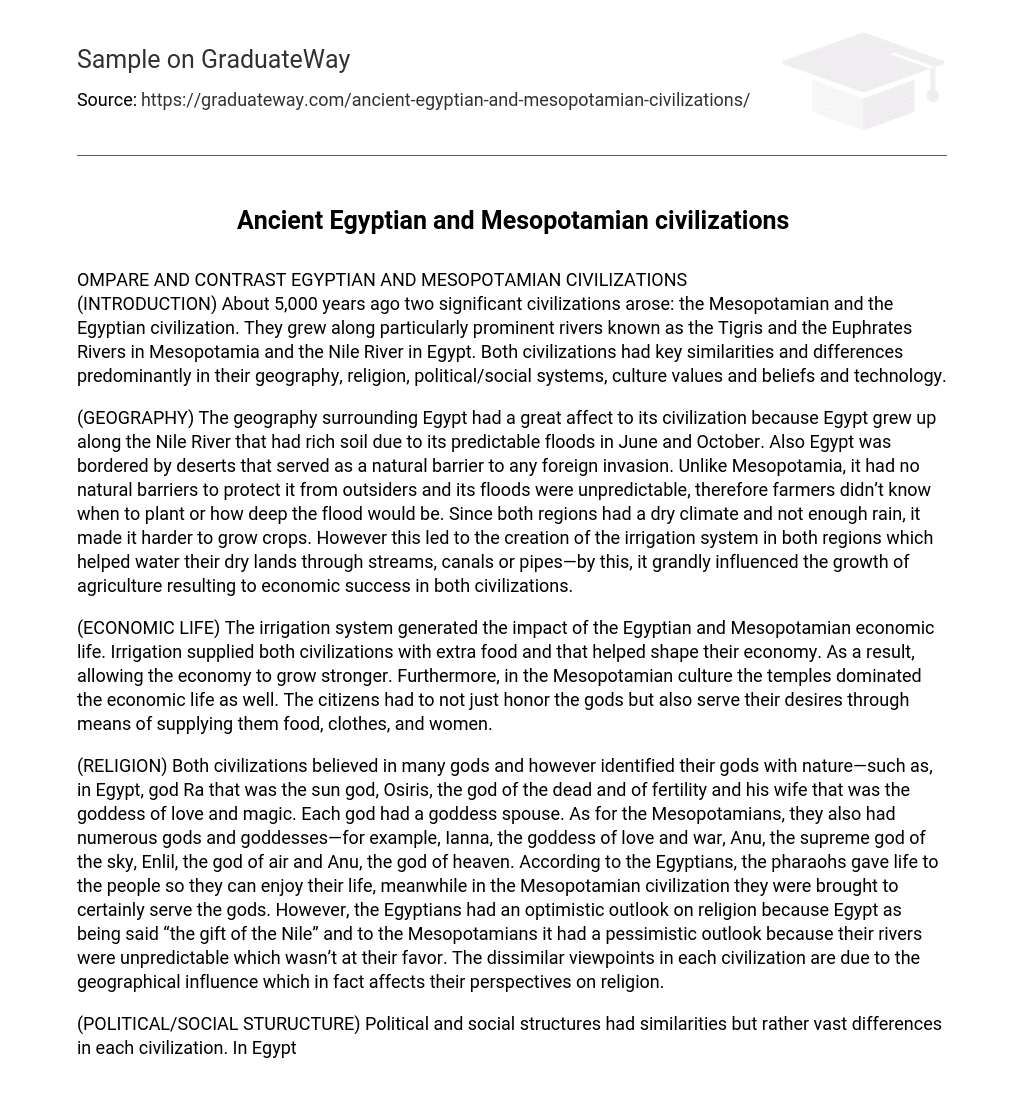OMPARE AND CONTRAST EGYPTIAN AND MESOPOTAMIAN CIVILIZATIONS
(INTRODUCTION) About 5,000 years ago two significant civilizations arose: the Mesopotamian and the Egyptian civilization. They grew along particularly prominent rivers known as the Tigris and the Euphrates Rivers in Mesopotamia and the Nile River in Egypt. Both civilizations had key similarities and differences predominantly in their geography, religion, political/social systems, culture values and beliefs and technology.
(GEOGRAPHY) The geography surrounding Egypt had a great affect to its civilization because Egypt grew up along the Nile River that had rich soil due to its predictable floods in June and October. Also Egypt was bordered by deserts that served as a natural barrier to any foreign invasion. Unlike Mesopotamia, it had no natural barriers to protect it from outsiders and its floods were unpredictable, therefore farmers didn’t know when to plant or how deep the flood would be. Since both regions had a dry climate and not enough rain, it made it harder to grow crops. However this led to the creation of the irrigation system in both regions which helped water their dry lands through streams, canals or pipes—by this, it grandly influenced the growth of agriculture resulting to economic success in both civilizations.
(ECONOMIC LIFE) The irrigation system generated the impact of the Egyptian and Mesopotamian economic life. Irrigation supplied both civilizations with extra food and that helped shape their economy. As a result, allowing the economy to grow stronger. Furthermore, in the Mesopotamian culture the temples dominated the economic life as well. The citizens had to not just honor the gods but also serve their desires through means of supplying them food, clothes, and women.
(RELIGION) Both civilizations believed in many gods and however identified their gods with nature—such as, in Egypt, god Ra that was the sun god, Osiris, the god of the dead and of fertility and his wife that was the goddess of love and magic. Each god had a goddess spouse. As for the Mesopotamians, they also had numerous gods and goddesses—for example, Ianna, the goddess of love and war, Anu, the supreme god of the sky, Enlil, the god of air and Anu, the god of heaven. According to the Egyptians, the pharaohs gave life to the people so they can enjoy their life, meanwhile in the Mesopotamian civilization they were brought to certainly serve the gods. However, the Egyptians had an optimistic outlook on religion because Egypt as being said “the gift of the Nile” and to the Mesopotamians it had a pessimistic outlook because their rivers were unpredictable which wasn’t at their favor. The dissimilar viewpoints in each civilization are due to the geographical influence which in fact affects their perspectives on religion.
(POLITICAL/SOCIAL STURUCTURE) Political and social structures had similarities but rather vast differences in each civilization. In Egypt the pharaoh was ultimately the only ruler but however was controlled by the vizier, the priest of ma’at. The government was run by religion—the concept of ma’at. The pharaoh’s duty was to maintain ma’ats teachings through his rulings. Surely, if ma’at was properly followed it will allow material success of the individual. Egypt was also more centralized due to the unification when Upper Egypt toke over Lower Egypt in 3,100 b.c. Egypt had no formal laws because it was important to follow the religious principles familiarized in ma’at. Meanwhile, Mesopotamian political system was disunited because of the many city-states which resulted in war conflicts between powers. Although unlike Egypt, it had a strict law code which was the Hammurabi law code. The Hammurabi law code presented countless laws along with its penalties if any of the laws were broken.
(TECHNOLOGY) Each civilization introduced its similar and different inventions as well. The Mesopotamians and Egyptians were the first to come up with effective writing systems. The Mesopotamians invented the cuneiform, while the Egyptians invented the hieroglyphics pictography. Also both built similar types of pyramids. The Mesopotamians had built the ziggurats that they believed was the “stairway to heaven” because it created a connection between their gods and the Egyptians build the Giza pyramids as tombs for their dead kings and pharaohs. Even though, the Mesopotamians were the only ones to invent the wheel that helped them move around faster, the Egyptians were the only ones to invent paper, made from papyrus.
(CONCLUSION) Finally, both civilizations had remarkable turning points in history. It is important to realize that each had contributed similar and different achievements that still hold recognition in today’s culture. We will continue reading their history and witness their magnificent landmarks as we pay a visit to Egypt and Mesopotamia, which is now Iraq.





